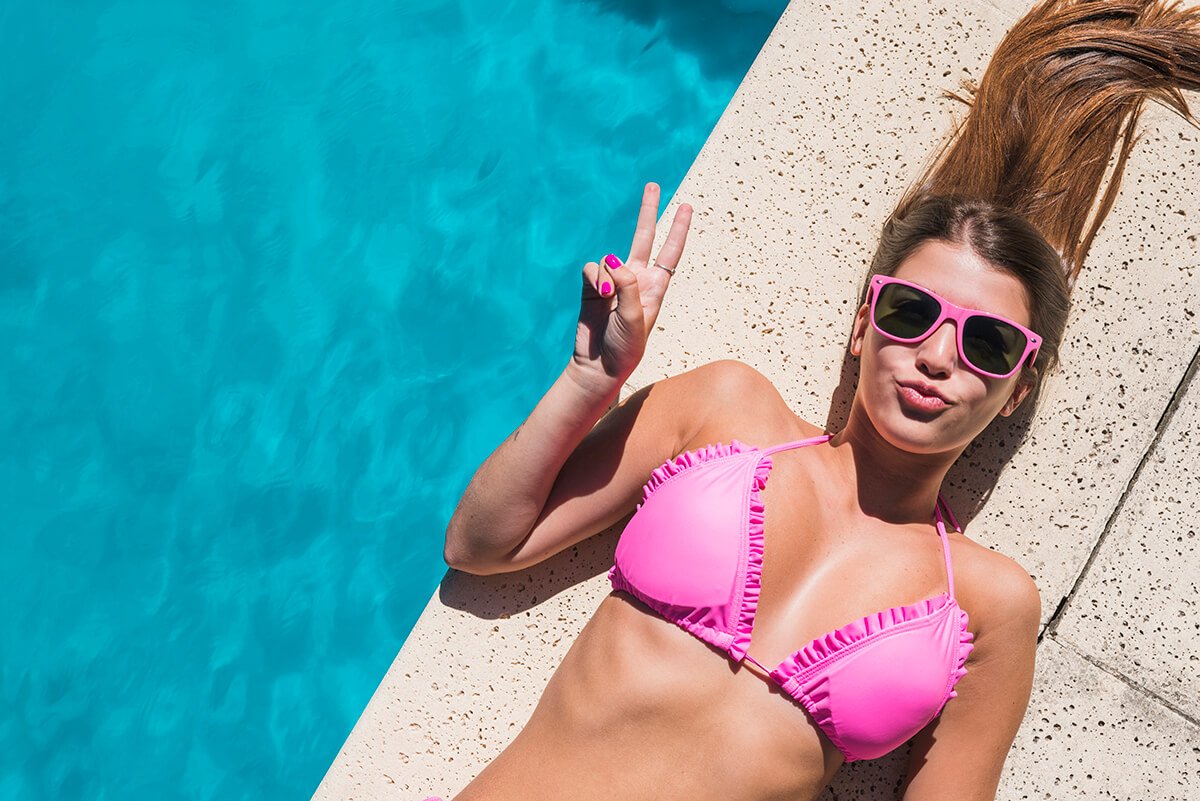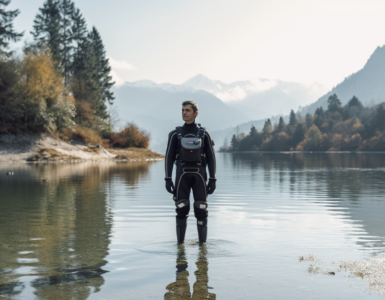Summertime for everyone means heading to the pool to soak up the warm water and get a healthy dose of exercise while spending time with family and friends. But, there’s a catch. Swimming pools are treated with chlorine and other chemicals to keep them clean, which is sadly bad for your hair and skin.
Fortunately, you don’t have to worry. With the right steps, you can easily protect hair from chlorine and enjoy your dip in the pool!
How to protect hair from chlorine
Here are 6 simple and easy to follow steps to keep your hair and scalp safe from the harsh effects of a chlorinated pool. We’ll help you keep your hair looking gorgeous, shiny, and healthy all summer.
1. Apply coconut or olive oil
Apply a healthy dose of coconut or olive oil onto your hair and scalp to act as a water shield and to replace the natural oils that the pool water will strip off of your hair.
2. Wet your hair
Rinse your hair with fresh running water before diving into the pool, and every half-hour afterward, to keep pool water away from your hair shafts.
3. Wear a swim cap
If you have weak, damaged, or treated hair, the best option is to wear a well-fitting swimming cap to prevent your hair from getting wet with pool water.
4. Use a conditioner
Use a conditioner if you don’t already do so, or use more than your usual amount during the days before and after swimming in chlorinated water.
5. Try natural remedies
Rinse your hair after swimming with apple cider vinegar to remove chlorine deposits and other unhealthy buildups. You can also use aspirin dissolved in water to wash off the green tint.
6. Shampoo afterward
Wash off the dirt, chemicals, and chlorine buildup with plenty of running water and a clarifying or damage repair shampoo.
Is chlorine bad for your hair?
You probably already know that most pools are dosed with a bit of chlorine to keep it clean and relatively free from bacteria and germs so you can swim safely. But, the question is, what does chlorine do to your hair?
Well, chlorine strips your hair of its natural oils, making it dry, dull, and sticky. Other effects of chlorine on hair include making it less shiny, more coarse and brittle, and more prone to breakage and split ends.

How to protect your hair in the pool
Now that you know just how bad chlorine is for you, you should understand how important it is to protect your hair from these harmful effects. Let’s go into more detail on how each of the steps we mentioned above can help you keep your hair safe and healthy.
Coconut or olive oil
Natural oils like olive oil or coconut oil work great not just for healthy meals, but for your hair and body as well. These oils keep the chlorinated water away from your hair shaft and follicles, plus, get so many more benefits. These two reinforce the natural sebum that your scalp produces, nourish and strengthen your hair shaft, and seal in moisture to keep your hair from becoming dry and lifeless.
Wet your hair
The common practice before diving into a pool is to take a quick shower to wet your hair and body. If you’ve ever stopped to ask yourself why, here’s the answer: wet hair (and skin) is slicker and less absorbent and porous. This means that you can move much easier in the water, and you don’t have to worry about chemicals clinging on to your scalp and skin and getting absorbed by your hair.
Wear a swim cap
If you want the easiest method to protect your hair, go for a swim cap that will keep your hair dry and covered. This is especially important if you are an avid swimmer who’s always swimming every day. Wearing swim caps for natural hair is also a great solution if you don’t want to have to start applying a bunch of substances on your naturally healthy and vibrant hair.
Use a conditioner
Conditioners are amazing hair products that moisturize your hair and keep it shiny. But, if you don’t want to use it regularly, you can always opt for a leave-in conditioner whenever you go swimming. You may also partner it up with a post-swim hot-oil repair treatment to give your hair extra shine and hydration.
Try natural remedies
Apple cider vinegar is a great product with a variety of uses outside of your kitchen. Using it to rinse your chlorine damaged hair not only eliminates any leftover chlorine deposits, but also clears your hair and scalp off of dead skin cells and other dirt buildup that clog your hair follicles and dull the shine of your hair.
You can also try dissolving aspirin in water and use that to rinse your hair and scalp. It should help especially if you have blonde or bleached hair tainted with a green tint from the chlorinated pool water.
Shampoo afterward
Finally, it’s important to rinse off after swimming, to remove all the dirt and chemical buildup on your hair and skin. For thorough cleaning, use a clarifying shampoo, but make sure to apply conditioner afterward to avoid making your hair dry.
Rinsing off is especially important if you have color-treated hair since chlorine can strip off hair dye, and act like a bleach turning your hair into a lighter (not in a good way) color, and make it more brittle.
How to keep your hair healthy after swimming
Now that you know the basics of pre-swim protection for your hair, it’s just as important that you understand how to take care of your hair after swimming. Here are some tips on how to get chlorine out of hair:
Use a clarifying shampoo
As we have mentioned earlier, clarifying shampoos are great options for chlorine removal shampoos. They don’t just wash off chlorine residue, but work in deep cleaning your hair and scalp from all other chemical and dirt buildup.
Condition your hair
Basic essential hair care includes not only shampoo, but conditioner as well, so as to keep your hair moisturized, fluffy, and full of life. Its especially true if you went for a swim, because your hair will be drier than usual.
Try a deep treatment masque
If you’ve been in the pool too long, forgot to apply hair protection, or swim in the pool regularly, your hair may be more damaged than usual, so it might be a good idea to take it a step further and try specialized treatments for chlorine damaged hair.
Use a wide comb tooth
If your hair is already dry and brittle, don’t make things worse by forcing a fine-toothed comb through the frizz and tangles. This will only break your hair or pull it out of your scalp. Use a wide comb tooth and brush your hair gently.
Chlorine and hair dye
It’s glaringly obvious: chlorine is bad for natural hair. But what about bleached hair?
Did you know that pool water can turn bleached hair green? Copper oxidizes the hair shaft, which produces a green tint on blonde hair. So, for example, you have purple hair, when you soak it in pool water, you’ll get a lighter color with a greenish hue.
This is why it’s a must to apply some coconut oil after drying your hair since it’s more prone to damage.
Hairstyles for swimming
Another great way to keep your hair somewhat protected while still looking stylish and fabulous is to dress it up in swim safe pool hairstyles.
Braided ponytail
Take a simple ponytail a step further by braiding it, so it’s more intact and less of your hair is readily exposed to the pool water.
French or fishtail braid
Better yet, go for a french braid or fishtail braid for a better look.
Top knot bun
Of course, you can always put your hair into a messy-but-cute top knot for an easy, foolproof hairdo that keeps your hair adequately safe.
Is chlorine bad for your skin?
Just like it’s bad for your hair, chlorine is also bad for your skin. It can cause dry skin and many other mild to serious issues, so it’s important to practice proper skincare, such as by using chlorine removal body wash and chlorine neutralizing lotion. You can easily find a great and affordable lotion and chlorine body wash online.
At a glance
Swimming in the pool is fun especially during the summer, but the chlorine is bad for your hair and skin. In order to protect hair from chlorine, remember to either wear a swim cap, or apply coconut oil, wet your hair, and wash your hair with shampoo and conditioner (or a natural alternative) afterward.




